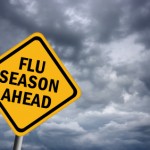The worst flu pandemic of all time began near the end of World War I, in the fall of 1918. It killed, in the next year, somewhere between 20 and 50 million people across the globe. The comparison to WW I deaths, eight and a half million from all countries involved, is striking.
There had been major influenza pandemics before and since, some severe and some relatively mild. The term itself conventionally refers to a worldwide outbreak of an infectious disease with some adults in every continent (except Antarctica) involved, but doesn't imply how lethal the illness is. For example the H1N1 "swine flu" pandemic in 2009-2010 involved 74 countries, but the death rate was relatively low.
Stanford University has a superb description of the so-called Spanish flu online. Usually flu kills the very young and the very old more than young adults; this time was different with far more deaths between the ages of 20 and 40 (some say 20-50 and others 15 to 34) than in the typical flu season. The influenza-related death rate, normally about 0.1%, has been estimated at 2.5 to 3% and may have been even higher. A fifth to a third of everyone alive at the time caught the virus, so half a billion victims may have been inflicted.
For Americans, including soldiers, the end of the war was near, but over 40,000 servicemen and nearly two-thirds of a million back home would die of this modern plague.
The precise origin of the disease is unclear; swine were affected in a nearly simultaneous fashion, but have not been blamed for the human ailment. The war itself and its resultant transportation of large numbers of troops, could have facilitated its spread globally. A first wave of the infection struck American army encampments in the United States, but was comparatively mild, at least when contrasted to the second and third outbreaks later in 1918 and then in 1919.
Public health measures were widely instituted, but the actual effectiveness of quarantine, gauze face masks, limited school closures and banning of public events is unknown.
In the midst of what for many was a typical flu infection, some developed a highly virulent form of the disease, with a strikingly abrupt onset, fever, exhaustion and rapid progression to pulmonary complications and death.
Many cases developed secondary bacterial infections and one species of bacteria was initially blamed for the disease. Then two French scientists reported a filter-passing virus in the British Medical Journal in November 1918. They used filtration to remove bacteria from the sputum coughed up by a flu patient and then injected the remaining fluid into the the eyes and noses of two monkeys. After their primate subjects were noted to have fevers, a human volunteer was given a subcutaneous injection of the same filtrate. He was the only person in their laboratory to develop the flu.
The extraordinary mortality rate of the 1918 influenza is shown on a graph plotting deaths in America from a variety of common infectious diseases over the years from 1900 to 1970. Another way to gauge the impact of the pandemic is to note that average life expectancy in the United States fell by ten years for that period.
And yet the incidence of influenza ebbed and since 1920 we've returned to the normal cycle of seasonal flu, intermittent epidemics and occasional pandemics, none as severe and deadly as the Great Flu of 1918-1919.



